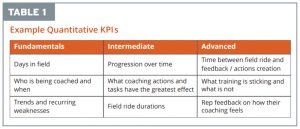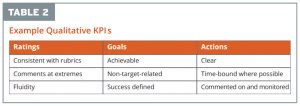10 Steps for Better Global Field Coaching
Feature Story – By Simon Mormen
Here is a 10-step starter guide to improving global field coaching effectiveness.
As we are all aware the “world market” has become a reality in the last 10 years. As a result, successfully managing and improving your field coaching effectiveness at a global level is the key to significant organizational success. Effecting change only within one business franchise or country is no longer enough. It is critical to look at your field force from a global level to assess gaps and apply coaching best practices across the entire organization.
To that end, here is a 10-step starter guide to improving global field coaching effectiveness.
 Step 1: Defining the Skills & Competencies for Success
Step 1: Defining the Skills & Competencies for Success
You will need a consistent way of ascertaining what it is your managers need to coach the representative on, normally consisting of a pre-defined number of competencies, skills and behaviors that outline clearly what is needed from a high-performing representative in your organization.
This means you will have to construct a set of selling competencies or a sales model, then share and obtain buy-in and input from all markets where you hope to use it. You may decide to amalgamate business, selling, communication or interpersonal skills for instance. What is most important is that the organization has agreed that, without excelling in these core skills, the sales person is unlikely to become a high achiever. Core skills should be easy to find; most HR departments already use them along with others that normally make up the annual performance review plan.
Step 2: Introducing a Consistent Rating Method
Of equal importance to the competencies (both functional and technical) is the addition of a clear rating scale. This scale should permit the ability to describe (ideally with reference to a detailed informational rubric) exactly what each of the rating levels looks like in a way that makes it simple for both the manager and the representative to agree on where they are.
Stay away from numbers and replace them with more meaningful words such as developing, satisfactory and role model. This enables a rich discussion that is critical in determining the specific skill or behavior that should be coached to elicit the greatest return on investment. It also clarifies to the representative the crucial “why” in the coaching conversation.
The scale should also allow entry of free text comments for the manager to accurately describe and validate the observations that led to their rating. An agreed-upon rating scale with distinct and detailed examples of each level goes a long way toward making the assessment and subsequent coaching of a skill clear for both the representative and the manager.
Both the manager and the representative should be held accountable for the content of a coaching plan.
Step 3: Enable the Manager to View the Representative’s Self-Perception
A pre-coaching self-diagnostic for the representative is proven to be a very powerful part of the coaching process, ensuring both representative and manager are completely aligned on current performance, perceptions, expectations and coaching focus, before, during and after the field ride.
This valuable, self-diagnostic gives reps the opportunity to evaluate their performance before a field ride, ideally for discussion in the pre-ride meeting, leading to greater clarity, understanding and alignment and a much more productive coaching conversation.
Step 4: Applying a Standard Coaching Method or Model
A coaching model is there to give consistency in coaching across the organization and most importantly to help the coach work methodically and clearly through predefined steps. This ensures that the representatives not only understands what needs doing, but also what they were not doing and possible reasons why.
There are many flavors of coaching models. You will find many examples with a quick web search. Most are proprietary, so you may need to pay to use them if you don’t already own one.
Step 5: The Coaching Plan
There needs to be an easily-accessible living and breathing coaching plan. The plan should align directly to the skills and competencies required to be successful. Ideally a coaching plan should have a maximum of three skills or objectives to be coached to enable focus and avoid representative overload, each with clear action steps assigned.
Both managers and representatives must be able to access the plan easily, remotely and ideally offline, so that constant adjustments and additions can be made to the coaching plan and it becomes a living document.
Step 6: Making Coaching Part of Management Behavior
Aside from competencies and skills, a manager needs to log additional relevant points for the representative: current sales results, marketing strategies and local execution and other to-dos that ultimately support technical and functional competencies. By creating a centralized repository where previously disparate pieces of information are now accessible all in one place, the manager can build the history of the representative more clearly and create a sound and forward-looking plan that challenges the representative positively.
Step 7: Representative Buy-In
Both the manager and the representative should be held accountable for the content of a coaching plan. Specifically, the manager for the coaching of the representative and the representative for the completion of actions and tasks that are assigned through discussion. Accountability comes easily, once both the manager and the representative get into the habit of asking for the detail on what they have done, what happened as a result and what should be done differently.
You would be amazed at how such a simple addition to everyday management changes a person, team and culture for the better!
Take a step back and take a fresh look. Often many of the processes you already have are excellent and firmly place you on the road to success.
Step 8: Support Materials
Support of the managers is key. Access to training materials and solutions that address each of the key skills that you are asking the manager to coach should be as easy as clicking a button! Nothing is more frustrating and demotivating for your manager than coaching to or rolling out programs with outdated, partial or nonexistent training material to back them up.
Step 9: Uptake and Success Measurement
This is without a doubt the most important part, where the effort that goes into making Steps 1 – 8 happen really pays off.

 Key performance indicator (KPI) reporting enables you to piece together the true picture of the team’s skills and field coaching activity and make country on country comparisons: What is working and not working, where there are areas of excellence and where there are areas that need attention.
Key performance indicator (KPI) reporting enables you to piece together the true picture of the team’s skills and field coaching activity and make country on country comparisons: What is working and not working, where there are areas of excellence and where there are areas that need attention.
Being able to access that information instantly – at every level of the organization – is critical. How easily you can get at those metrics will come down to your current mechanism for capturing coaching that we discussed earlier.
See Tables 1 and 2 for qualitative and quantitative reports. The actual KPIs you put in place can be varied and weighted to suit your organizational coaching culture and targets.
Step 10: Selecting the Right Tool for the Job
Objectively reviewing a coaching process can be tough. If you are looking to really improve your sales force effectiveness, the benefit of Steps 1-9 can only be harvested if you are able to view, easily, what is currently happening and why – in real time.
Take a step back and take a fresh look. Often many of the processes you already have are excellent and firmly place you on the road to success. Most of the changes needed revolve around bringing all the disparate elements together and demonstrating to both manager and representatives how easy and valuable coaching can and should be.
Whatever tool you select must be scaleable, translatable and adhere to global data privacy regulations (GDPR in Europe for instance). It should also be easy enough for managers and representatives to adopt, but intelligent enough to display the necessary metrics and KPIs simply, meaningfully and on demand. You will also need a “training-in-a-box” package that is easy for countries to translate and train their teams.
With this powerful information in place, you are in an informed position to steer your people and their teams in the right direction.
Simon Mormen is managing director of Atomus. Email Simon at
simon.mormen@atomus.com.









